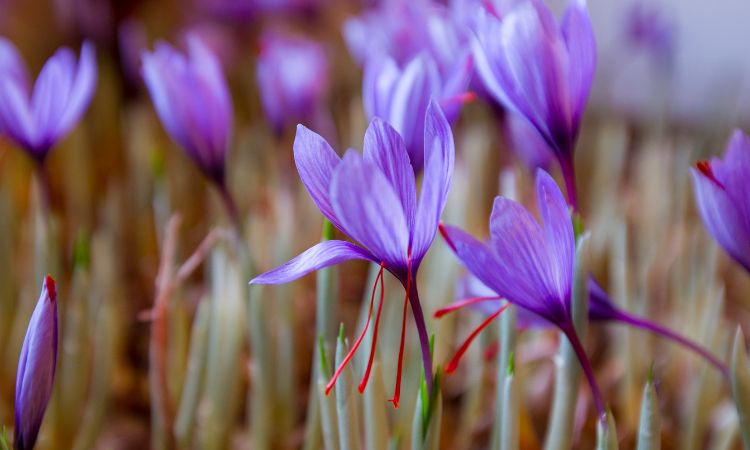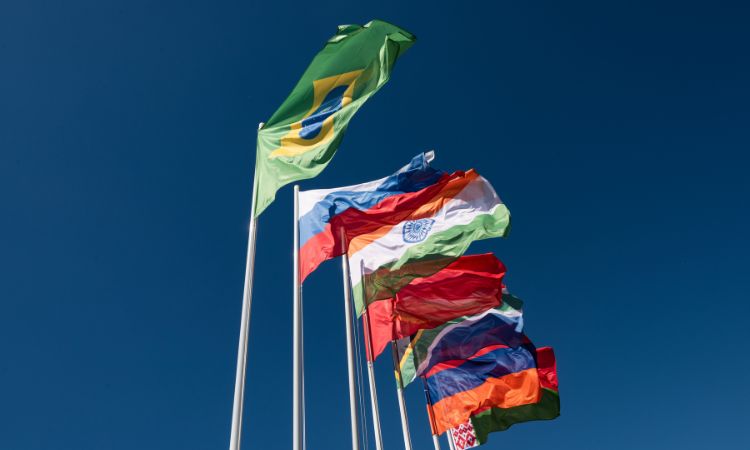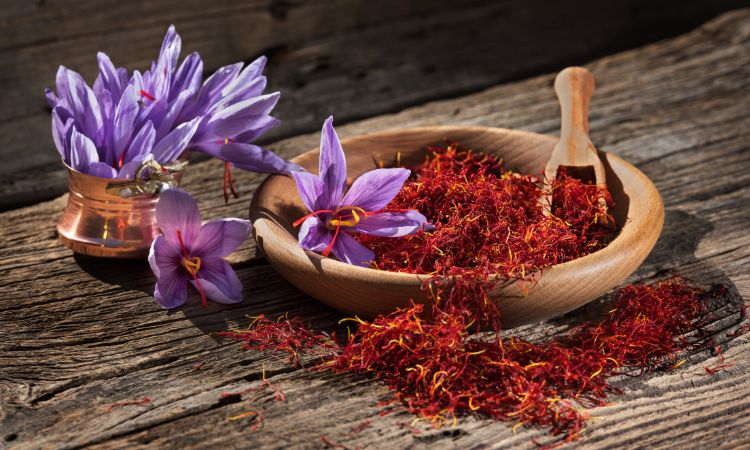Saffron, the world’s most precious spice, has long been a significant player in global economies, commanding a unique position in international trade. This captivating analysis delves into the intricate tapestry of saffron’s influence, highlighting its remarkable journey from ancient trade routes to modern-day markets. Explore the historical evolution, premium market status, and economic impact of this versatile spice across diverse regions and communities.
Key Takeaways on Saffron in Global Economies
- Saffron’s historical significance as a coveted spice in global trade networks
- Understanding the premium market position of saffron and its influence on international markets
- Insight into the major saffron-producing nations and their market share
- Examining the economic impact of saffron cultivation on rural communities
- Exploring the current market dynamics, trade regulations, and technological advancements in the saffron industry
The Historical Evolution of Global Saffron Trade
The captivating history of saffron trade spans millennia, tracing its origins to ancient civilizations and the intricate network of trade routes that facilitated its global distribution. As a highly prized premium spice, saffron has long been sought after for its vibrant color, distinctive aroma, and versatile culinary and medicinal applications.
Ancient Trade Routes and Historical Markets
Saffron’s journey around the world can be traced back to the ancient Mesopotamian, Persian, and Mediterranean civilizations, where it was extensively cultivated and traded. The famed Silk Road played a crucial role in the global dissemination of this valuable agricultural export, connecting saffron-producing regions in the East to the lucrative markets of the West.
Traditional Uses Across Civilizations
- In ancient Greece and Rome, saffron was highly prized for its use in perfumes, dyes, and ceremonial rituals.
- In Persia and the Middle East, saffron was revered for its medicinal properties and incorporated into traditional cuisine.
- In China and India, saffron was used in traditional medicine, as well as in religious and cultural practices.
Development of Early Trading Networks
As the demand for saffron grew, intricate trading networks emerged, connecting producers, merchants, and consumers across continents. Caravans traversed treacherous mountain passes and desert routes, transporting the precious saffron cultivation to global markets, where it was highly sought after and traded for valuable commodities.
| Historical Saffron Trade Routes | Key Trading Hubs |
|---|---|
| Silk Road | Samarkand, Bukhara, Tashkent |
| Mediterranean Sea Trade | Alexandria, Rhodes, Athens |
| Indian Ocean Trade | Calicut, Goa, Hormuz |
The historical evolution of the global saffron trade has been marked by its enduring cultural significance, the resilience of ancient trade routes, and the ever-evolving dynamics of supply and demand that have shaped this captivating industry over the centuries.
Understanding Saffron’s Premium Market Position
Saffron, the world’s most expensive premium spice, has long been revered for its unique aroma, vibrant hue, and versatile culinary applications. This revered spice’s premium status is largely attributed to its labor-intensive cultivation process and limited production regions. The delicate saffron crocus flowers must be hand-picked and processed with great care, contributing to its high economic impact and position in international markets.
The cultivation of saffron is a meticulous task that requires significant human labor. Each saffron flower produces only three tiny stigmas, which must be meticulously harvested and dried to yield the coveted saffron spice. This painstaking process, along with the fact that saffron can only be grown in specific climates, contributes to its scarcity and high market value.
| Saffron Producing Regions | Estimated Global Market Share |
|---|---|
| Iran | 90% |
| India | 5% |
| Greece | 2% |
| Morocco | 1% |
| Spain | 1% |
The limited production regions, primarily centered in Iran, India, Greece, Morocco, and Spain, further contribute to saffron’s exclusivity and high demand in international markets. This scarcity, combined with the spice’s exceptional culinary and medicinal properties, has earned saffron a reputation as a premium spice coveted by chefs, consumers, and industries worldwide.
Major Saffron-Producing Nations and Their Market Share
The global saffron trade is dominated by a few key players, with Iran emerging as the undisputed leader in saffron farming and production. This ancient spice, prized for its unique flavor, aroma, and vibrant color, has become a valuable agricultural export for several nations around the world.
Iran’s Dominance in Global Production
Iran accounts for over 90% of the global saffron production, with its saffron farmers cultivating the majority of the world’s supply. This Middle Eastern nation’s climatic conditions, traditional growing methods, and extensive experience in saffron cultivation have solidified its position as the global leader in this lucrative agricultural export.
Emerging Production Regions
While Iran’s saffron farming continues to dominate the global market, other regions are emerging as significant players in the saffron trade. Countries like Spain, Greece, Morocco, and India have seen increased saffron production in recent years, catering to the growing demand for this premium spice worldwide.
Quality Standards and Regional Variations
- Saffron quality is heavily influenced by the growing conditions, harvesting techniques, and processing methods employed in different regions.
- Iran’s saffron is widely recognized for its superior quality, with its distinct flavor, aroma, and deep-red color.
- Other saffron-producing regions, such as Spain and Greece, have also developed their own unique quality standards and regional variations, appealing to the preferences of specific markets.
The saffron industry’s global landscape is a complex tapestry, with Iran’s dominant position, emerging production regions, and diverse quality standards shaping the dynamics of the international saffron farming, global trade, and agricultural export markets.
Economic Impact of Saffron Cultivation on Rural Communities
Saffron farming, a labor-intensive yet highly valuable agricultural pursuit, has long been a cornerstone of rural economies in producing regions. The cultivation of this precious spice offers a remarkable economic lifeline for communities, generating substantial income and employment opportunities that can transform the lives of residents.
In regions like Iran, the world’s leading saffron producer, saffron farming plays a vital role in sustaining rural livelihoods. According to industry experts, the economic impact of saffron cultivation extends far beyond the farm, with the spice’s agricultural exports contributing significantly to the country’s overall economic growth.
- Saffron farming provides a reliable source of income for small-scale farmers, allowing them to support their families and invest in the future.
- The labor-intensive nature of saffron cultivation creates numerous job opportunities, particularly during the harvesting season, boosting local employment and economic activity.
- The processing and trade of saffron also generate additional revenue streams, fostering the development of small-scale businesses and cottage industries in rural areas.
The economic benefits of saffron cultivation extend beyond individual farmers and communities, as the spice’s agricultural exports contribute to the overall strength of national economies. In Iran, for example, saffron is a significant non-oil export, generating substantial foreign exchange earnings and supporting the country’s broader economic development.
“Saffron cultivation has been a lifeline for countless rural families, providing a reliable source of income and economic opportunity in regions where alternative employment options are limited.”
As the global demand for saffron continues to grow, the economic impact of this unique spice on rural communities is poised to become even more pronounced, transforming the lives of farmers and supporting the long-term prosperity of producing regions.
Saffron in Global Economies: Current Market Dynamics
The global spice industry has witnessed a surge in the demand for saffron, a premium spice known for its vibrant color, distinct aroma, and diverse culinary applications. As saffron continues to captivate international markets, understanding the current market dynamics is crucial for navigating the global trade landscape.
Price Fluctuations and Market Trends
Saffron prices are renowned for their volatility, fluctuating based on various factors such as supply, weather conditions, and geopolitical events. In recent years, the saffron market has experienced significant price swings, with producers and consumers alike navigating the challenges of price volatility. Factors like changes in production levels, shifting consumer preferences, and logistical challenges have all contributed to the dynamic nature of saffron prices.
- Saffron prices can range from $500 to $5,000 per pound, depending on quality and origin.
- The Iranian saffron market, which accounts for a significant portion of global production, is a key driver of price movements.
- Emerging producers in regions like Kashmir and Spain are also shaping the global saffron market trends.
Supply Chain Economics
The saffron supply chain is a complex network that involves various stakeholders, from growers and processors to wholesalers and retailers. Understanding the supply chain economics is crucial for identifying opportunities and challenges in the saffron industry. Factors such as labor costs, transportation logistics, and storage requirements can significantly impact the overall profitability and accessibility of saffron in global markets.
| Supply Chain Stage | Key Considerations |
|---|---|
| Cultivation | Labor-intensive process, climate-dependent yields |
| Processing | Delicate handling, strict quality standards |
| Distribution | Logistics challenges, transportation costs |
| Retail | Pricing strategies, market access |
As the saffron industry continues to evolve, understanding the current market dynamics and supply chain complexities will be crucial for producers, traders, and consumers alike to navigate the global spice industry effectively.
International Trade Regulations and Quality Control
In the global trade of premium spices like saffron, stringent regulations, and quality control measures play a crucial role in maintaining the integrity of the industry. The international markets demand transparency and traceability to ensure the authenticity and purity of saffron products reaching consumers worldwide.
Saffron, renowned for its vibrant color and distinct aroma, is subject to a comprehensive regulatory framework governing its export and import. Governing bodies around the world have established guidelines and standards to prevent adulteration and ensure saffron’s quality and safety.
Exporting and Importing Regulations
Saffron-producing nations have implemented robust export regulations to protect their prized commodity. Exporters must adhere to specific documentation, labeling, and traceability requirements to verify the origin and authenticity of their saffron shipments. Similarly, importing countries have established strict import guidelines to scrutinize saffron consignments and prevent the entry of counterfeit or substandard products.
Quality Control Measures
- Rigorous inspections and testing of saffron samples to assess color, aroma, and purity
- Certification programs that validate the origin, cultivation, and processing methods used
- Collaboration between regulatory bodies and industry stakeholders to develop comprehensive quality standards
- Advanced analytical techniques, such as spectroscopy and chromatography, to detect adulteration
These quality control measures, combined with the robust regulatory framework, aim to safeguard the integrity of the global saffron trade, preserving the reputation and value of this premium spice in international markets.
| Regulation | Purpose | Key Aspects |
|---|---|---|
| Export Guidelines | Ensure saffron authenticity and traceability |
|
| Import Regulations | Prevent entry of counterfeit or substandard saffron |
|
By upholding these international trade regulations and quality control measures, the global saffron industry can safeguard the reputation of this premium spice, ensuring consumers worldwide receive a product that meets the highest standards of authenticity and quality.
Modern Processing Technologies and Value Addition
In the dynamic world of the spice industry, saffron cultivation has evolved significantly, with innovative processing technologies and value-addition techniques revolutionizing the global saffron trade. These advancements have not only enhanced the quality and consistency of saffron but also opened new opportunities for producers and consumers alike.
Innovation in Harvesting Methods
The traditional manual harvesting of saffron stigmas has given way to more efficient and ergonomic techniques. Mechanical harvesters and specialized tools have streamlined the process, reducing labor costs and improving productivity. These innovations have been particularly beneficial for saffron-producing regions, where saffron cultivation plays a crucial role in agricultural exports and the local spice industry.
Processing Standards and Certification
To ensure the integrity and quality of saffron in global markets, industry stakeholders have established stringent processing standards and certification programs. These measures encompass stringent quality control checks, traceability protocols, and the implementation of best practices throughout the value chain. Such initiatives not only instill consumer confidence but also elevate the reputation of saffron as a premium spice industry product.
| Processing Technology | Benefits |
|---|---|
| Automated Drying Systems | Consistent moisture content, reduced labor, and improved efficiency |
| Advanced Sorting and Grading | Enhanced uniformity, reduced wastage, and higher-value saffron cultivation |
| Innovative Packaging Solutions | Improved shelf life, better preservation of aroma and flavor, and enhanced agricultural exports |
These technological advancements and quality-focused initiatives have positioned the saffron industry for continued growth and global recognition, solidifying its place as a coveted spice industry product.
Market Challenges and Price Volatility Factors
The global saffron trade faces various challenges that contribute to the industry’s price volatility. One of the primary issues is the limited supply of this precious spice. Saffron, grown primarily in Iran, Kashmir, and other specialized regions, has a delicate cultivation process that is heavily reliant on weather conditions and labor-intensive harvesting methods. This restricted supply often leads to significant price fluctuations, making the market susceptible to speculation and market manipulation.
Another challenge lies in the adulteration and counterfeiting of saffron products. Unscrupulous players in the international markets sometimes mix inferior or synthetic ingredients with pure saffron, deceiving consumers and undercutting legitimate producers. This practice not only erodes consumer trust but also distorts the true market value of genuine saffron.
- Restricted supply due to specialized cultivation requirements
- Susceptibility to weather conditions and labor-intensive harvesting
- Adulteration and counterfeiting of saffron products
- Distortion of market value and erosion of consumer trust
Furthermore, the saffron industry faces intense competition from other spices and flavors in the global trade, economic impact, and international markets. Consumers are increasingly seeking innovative and diverse culinary experiences, which can challenge the traditional dominance of saffron in certain applications. Adapting to these evolving market dynamics requires strategic positioning and continuous innovation from saffron producers and distributors.
“Addressing the challenges of price volatility and maintaining the integrity of the saffron supply chain are crucial for the long-term sustainability and growth of the global saffron industry.”
To overcome these obstacles, industry stakeholders must collaborate to enhance traceability, strengthen quality control measures, and promote the unique cultural and culinary value of authentic saffron. By addressing these pressing issues, the saffron trade can solidify its position in the global markets and ensure the enduring economic impact of this remarkable spice.
Investment Opportunities in the Saffron Industry
As the global saffron farming industry continues to evolve, savvy investors are taking notice of the compelling opportunities it presents. The spice industry, with saffron at its heart, offers a unique chance for both start-ups and established players to capitalize on its growing economic impact.
Start-up Potential and Market Entry
The saffron market is ripe with possibilities for innovative start-ups. Emerging technologies and efficient farming practices have lowered the barriers to entry, making it more accessible for entrepreneurs to establish themselves in the industry. From value-added processing to niche product development, there are numerous avenues for start-ups to carve out a competitive edge and tap into the expanding global demand for high-quality saffron.
Risk Assessment and ROI Analysis
Investing in the saffron industry requires a thorough understanding of the associated risks and potential returns. Factors such as climate variability, supply chain complexities, and price volatility must be carefully evaluated. However, the high value of saffron and its growing popularity as a premium culinary and medicinal ingredient makes it a compelling investment opportunity, with the potential for a strong return on investment (ROI). Diligent risk assessment and robust financial modeling can help investors navigate the industry’s nuances and make informed decisions.
The saffron industry presents a unique blend of challenges and opportunities, making it an intriguing prospect for both seasoned investors and aspiring entrepreneurs. By understanding the market dynamics, leveraging emerging technologies, and managing risks effectively, stakeholders can capitalize on the industry’s economic impact and secure a promising future in the dynamic world of saffron farming and trade.
Sustainable Practices and the Future of Saffron Production
As the demand for saffron, the world’s most expensive spice continues to grow, it’s crucial to explore sustainable practices that ensure the future of saffron cultivation. In this section, we delve into the eco-friendly methods and innovative approaches that are shaping the saffron farming industry, paving the way for a more sustainable and prosperous future.
One of the primary concerns in saffron production is water conservation. Saffron cultivation is a water-intensive process, and in many regions, water scarcity poses a significant challenge. Farmers are now exploring innovative irrigation techniques, such as drip irrigation and precision farming, to optimize water usage and reduce waste. These methods not only conserve precious water resources but also improve overall crop yields and quality.
- Adoption of organic farming practices, including the use of natural fertilizers and pest-control methods, is on the rise in the saffron farming community. These eco-friendly approaches not only benefit the environment but also produce high-quality agricultural exports that meet the growing demand for organic and sustainable products.
- Preservation of traditional cultivation methods is another crucial aspect of sustainable saffron production. Many saffron-producing regions have a rich history of hand-harvesting and processing techniques that have been passed down for generations. Initiatives to document and promote these time-honored practices ensure the preservation of cultural heritage and maintain the unique terroir that defines the world’s finest saffron.
As the global saffron cultivation industry looks towards the future, the adoption of sustainable practices will be paramount. By embracing innovative technologies, eco-friendly farming methods, and the preservation of traditional knowledge, the saffron industry can ensure a thriving and resilient future, meeting the ever-growing demand for this precious spice while safeguarding the environment and the livelihoods of the communities that cultivate it.
Digital Transformation in Saffron Trade
The global saffron trade is undergoing a digital revolution, with emerging technologies reshaping the way this premium spice is bought, sold, and distributed across international markets. E-commerce platforms have become a driving force, connecting saffron producers in nations like Iran and Spain with buyers in Asia, Europe, and the Americas. These digital marketplaces not only streamline transactions but also provide greater transparency, allowing consumers to trace the origin and quality of the saffron they purchase.
Blockchain technology has also made its way into the saffron supply chain, enhancing traceability and ensuring the authenticity of this valuable commodity. By recording each step of the production and distribution process on a secure, decentralized ledger, stakeholders can verify the provenance of saffron, mitigating the risk of counterfeiting and adulteration. This digital transformation is crucial for maintaining the integrity of the global spice industry and meeting the growing demand for premium, high-quality saffron.
Alongside e-commerce and blockchain, digital marketing strategies are also transforming the way saffron is promoted and sold worldwide. Saffron producers and exporters are leveraging social media, online advertising, and content marketing to reach a global audience, showcasing the unique features and benefits of their regional saffron varieties. This digital-first approach allows them to connect directly with consumers, building brand loyalty and driving sales in both emerging and established saffron markets.
FAQ
What is the significance of saffron in global economies?
Saffron is a highly valued spice that plays a significant role in international trade and the global economy. As a premium spice, saffron has a strong influence on agricultural exports and various markets worldwide.
How has the saffron trade evolved historically?
Saffron has a rich history, tracing its origins through ancient trade routes and traditional uses across various civilizations. The development of early trading networks facilitated the global distribution of this valuable spice.
What factors contribute to saffron’s premium market position?
Saffron’s high value is attributed to its labor-intensive cultivation process and limited production regions, making it a coveted commodity in the global market. The economic impact of saffron farming on rural communities is also significant.
Which countries are the major producers of saffron globally?
Iran dominates global saffron production, but emerging production regions are also contributing to the industry. Quality standards and regional variations in saffron cultivation play a crucial role in the market.
How does saffron cultivation impact rural communities economically?
Saffron farming provides economic benefits to rural communities, contributing to local economies, employment opportunities, and overall rural development in producing regions.
What are the current market dynamics of the global saffron trade?
The global saffron trade is influenced by price fluctuations, market trends, and supply chain economics. Understanding these factors is crucial for navigating the saffron industry.
What are the regulatory frameworks and quality control measures in the saffron trade?
International trade regulations and quality control measures are in place to ensure the authenticity and purity of saffron in global markets, maintaining the integrity of this premium spice.
How are modern processing technologies shaping the saffron industry?
Innovations in harvesting methods, processing standards, and certification processes are enhancing the quality and value of saffron, driving advancements in the spice industry.
What are the challenges and price volatility factors in the saffron market?
The saffron industry faces challenges such as price volatility, market competition, and issues related to adulteration and counterfeit products, which can impact the global trade dynamics.
What investment opportunities exist in the saffron industry?
The saffron industry presents investment opportunities, including start-up potential and market entry strategies. Risk assessment and return on investment analysis are crucial for potential investors.
How are sustainable practices shaping the future of saffron production?
Sustainable practices in saffron cultivation, such as eco-friendly farming methods and water conservation techniques, are crucial for the long-term sustainability of the industry.
How is digital transformation reshaping the saffron trade?
Digital technologies, including e-commerce platforms, blockchain applications, and digital marketing strategies, are transforming the global saffron market, enhancing transparency and efficiency.









